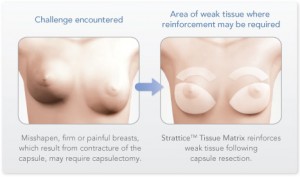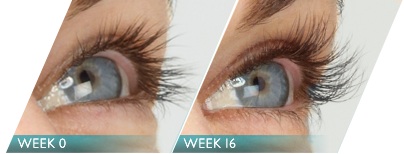Many difficult problems that can occur with breast surgery have been helped with the introduction of Strattice™, a biologic tissue support layer or matrix used to reinforce weakened tissues and enhance natural tissue regeneration.
Bottoming Out
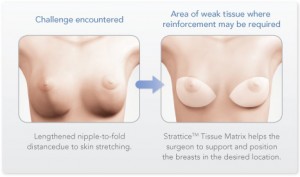
A lengthened nipple-to-inframammary fold distance due to skin stretching after surgery, and the breast pocket dropping lower than desired, can result in the nipple appearing to sit too high on the breast. A droopy or sagging appearance is produced when the skin below the nipple looks stretched and disproportionate in relationship to the overall size of the breast size. By attaching the Strattice™ internally to the fold, and chest muscle, the breast can be positioned in the desired location to correct this problem.
Fold Malposition
Fold malposition is a condition in which the fold under or lateral to the breast fold has become displaced. These folds give the breasts definition and help maintain the shape and position of the breasts. During breast augmentation surgery, a pocket is carefully created under the breast tissue. Breast folds act as important markers for the surgeon when creating the pocket and help to determine the surgical outcome. Loss of skin
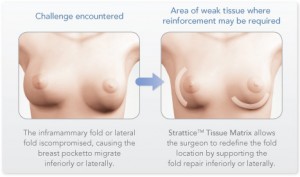
elasticity or a breakdown of pocket boundaries can occur over time due to the aging process and gravity. The inframammary fold, lateral fold, or both may be affected. The breast pocket may drift to the outside of the chest or appear to have dropped and will no longer be in the original desired position. Dr. Forley may recommend the use of Strattice™ to redefine the fold location inferiorly or laterally. This will support and hold the breasts in the desired location and achieve breast symmetry.
Symmastia
The normal appearance of breasts features a natural space between the breasts, which is defined by a gentle fold, referred to as the medial fold. The medial fold separates the breasts, giving them shape, form, and what is often referred to as cleavage. Even if the breasts are naturally large in size or have been enhanced, a degree of separation helps to give each breast definition. Symmastia is a condition in which the breasts sit too close
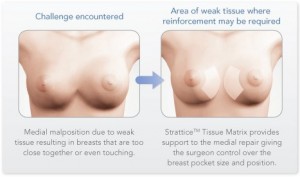
together or possibly even touch one another. It can occur following breast augmentation surgery if the breast pocket created was made slightly too large, the breasts have migrated out of their original position, or the fibrous tissue which creates the medial fold becomes weak or stretched. Strattice™ may be used to reinforce and support existing weak or inadequate tissue to restore the natural separation between the breasts.
Wrinkling and Rippling
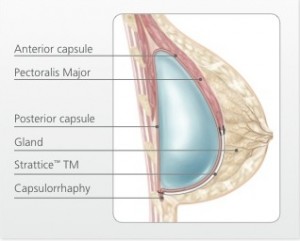
The quality of the skin that envelops the breast tissue significantly influences the shape and appearance of the breasts. There is natural and hereditary variation in the amount of elasticity and thickness of each person’s breast skin, which affects the overall appearance of the breasts. A rippled appearance may also occur if the breast augmentation pocket exceeds the optimum size needed to maintain the position of the breast implants. If the breasts migrate out of their original position because the breast pocket is too large, the appearance of rippling may occur on the breast skin where volume is deficient. Many women who have either minimal body fat or thin skin may experience this less than desirable condition, simply known as breast rippling and wrinkling, following breast augmentation surgery. Dr. Forley may consider reducing the size of the breast pocket and using Strattice™ to help provide additional support. Strattice™ is placed at the bottom of the breast to reinforce weak or inadequate tissue, which can help reduce the presence of wrinkles and ripples on the skin surface.
Capsular Contracture
Capsular Contracture is an unpredictable condition that may occur when naturally forming scar tissue surrounding the breast implant continues to increase in thickness. As thickness increases, it squeezes the implant causing tightness, firmness, and changes in breast appearance. Capsular contracture may occur in one or both breasts and may vary in degree and severity. Discomfort and changes in breast appearance may require additional surgery. Some corrective surgical outcomes may include partial or complete removal of the capsular scar tissue. Strattice™ reinforces weakened and inadequate tissue, which can help Dr. Forley to support and position the breasts in the desired location while allowing re-establishment of natural boundaries.
Augmentation Mastopexy
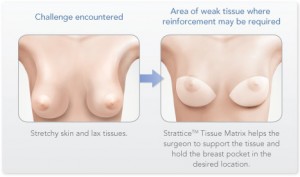
Augmentation mastopexy is a breast surgery procedure that enhances both the position and size of the breasts by adding volume with an implant and lifting the breast tissue that has sagged. Women who have lost a significant amount of weight, including those whose breast tissue has changed following childbirth and breastfeeding, are candidates for augmentation mastopexy.Thin, weakened tissues that may be insufficient to support the bottom part of the breasts can be reinforced with the use of Strattice™. During augmentation mastopexy surgery, Dr. Forley creates incisions using standard surgical techniques and then sutures Strattice™ to the chest wall and pectoralis major muscle to reinforce the breast pocket and help to keep the chosen implant in position. Removal of excess tissue and lifting of the breast is performed after this initial procedure has been completed.
Tags: bottoming out, Breast Augmentation, breast fold malposition, breast implants, breast lift, breast surgery, Capsular Contracture, mastopexy, Strattice, Symmastia
Written by Dr. Forley on March 29, 2012

